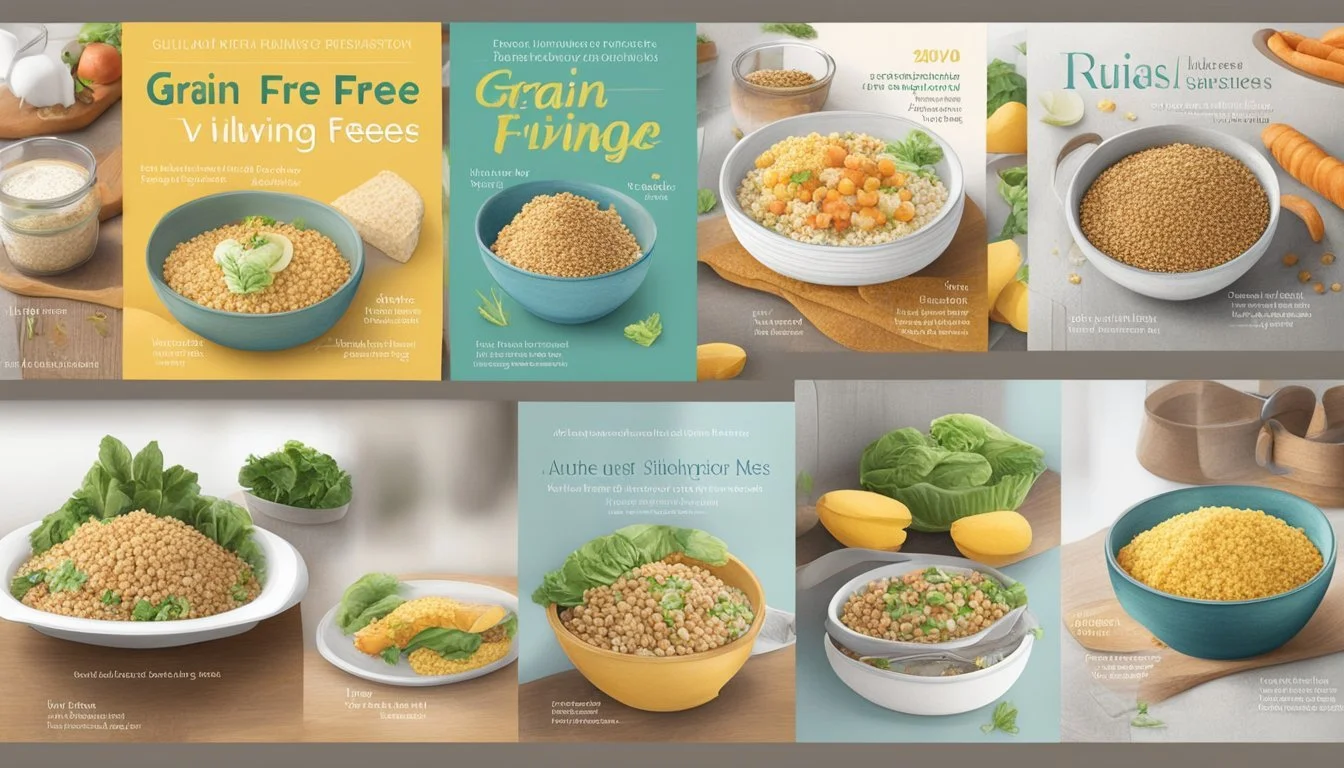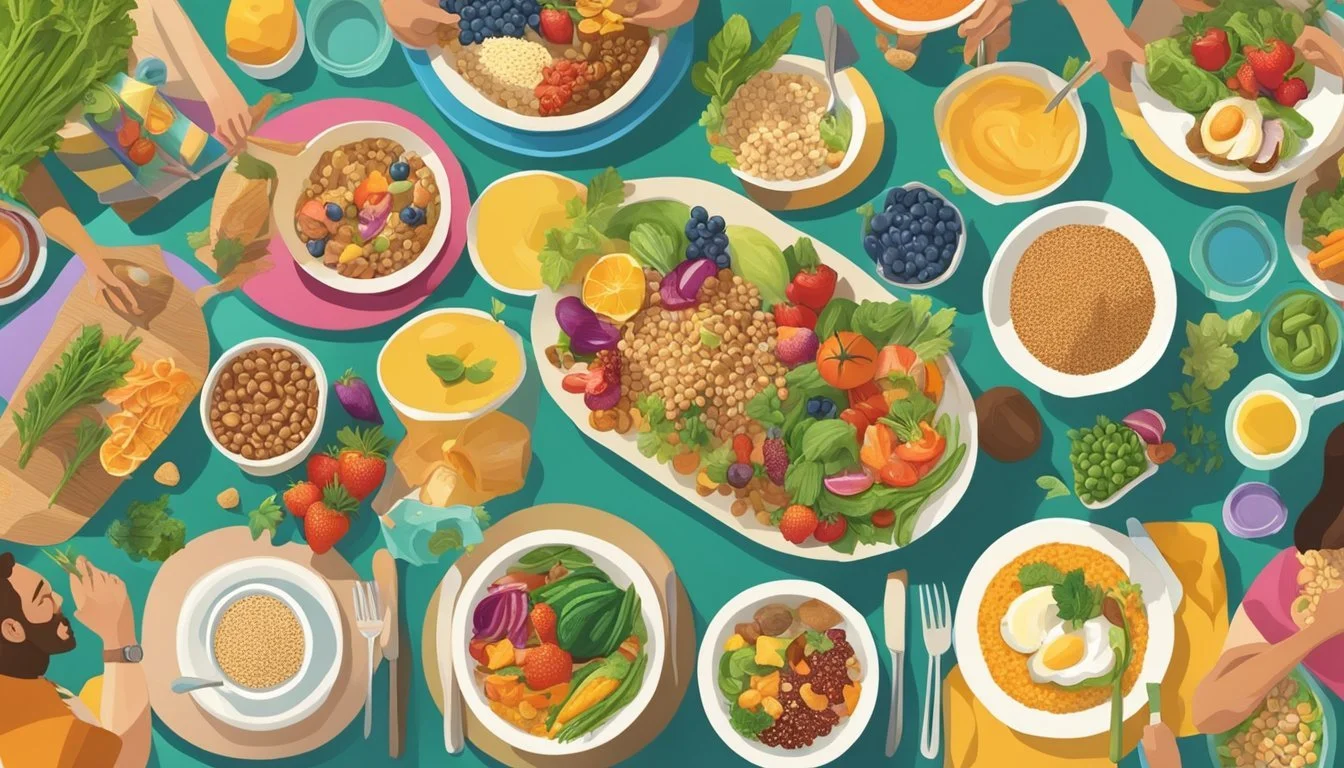Real-Life Transformations with Grain-Free Living
Unveiling the Benefits
Embarking on a grain-free lifestyle has been a transformative journey for many individuals seeking health improvements and a greater sense of well-being. Anecdotal success stories are plentiful, with experiences ranging from weight loss to relief from chronic conditions, illustrating the powerful impact that dietary changes can have on one's health. These stories are not about quick fixes but rather about long-term dedication to a new way of eating and living.
The shift away from grains, which constitute a large component of the standard diet, can often lead to significant physiological changes. Proponents of grain-free diets report an array of benefits including diminished inflammation, increased energy levels, and a reduction in digestive issues. Accounts of these transformations are increasingly common, with some individuals even attributing the alleviation of autoimmune symptoms to these dietary adjustments.
While personal narratives of triumph over health hurdles through grain-free living are compelling, these should be considered within the context of individual medical guidance and nutritional needs. Each transformation is unique, and the decision to modify one's diet in this way should be informed by both personal health goals and scientific evidence. The grain-free movement is not just about the omission of certain foods but rather about creating a new relationship with one's eating habits and attaining a more balanced approach to nutrition.
Real-life transformations with grain-free living can be truly inspiring, offering a journey towards improved well-being and a positive relationship with food. By embracing grain-free entertaining and hosting flavorful grain-free dinner gatherings, individuals can share the joy of nourishing cuisine with friends and family, fostering connections and a sense of vitality.
Being mindful of the impact on the grain-free gut microbiota and making informed choices can contribute to supporting digestive health and overall vitality, while promoting grain-free heart health. Additionally, exploring the diverse offerings in the grain-free products market can provide a wealth of options to enhance your dietary choices and support your well-being.
Engaging with grain-free food bloggers can offer valuable insights and inspiration, providing a community of support and creativity in your grain-free journey. Additionally, incorporating wholesome and satisfying grain-free snacks into your lifestyle can add convenience and nourishment to your daily routine.
Real-life transformations with grain-free living showcase the potential for positive change and well-being, offering a path to embracing a fulfilling and health-conscious approach to nourishment.
Understanding Grain-Free Living
Embarking on a grain-free lifestyle often involves a dietary overhaul that excludes all forms of grains from one's diet. This shift is usually aimed at enhancing overall health and well-being.
The Basics of a Grain-Free Diet
A grain-free diet eliminates all grains, including wheat, rice, corn, and barley. Followers of this diet often substitute traditional grain-based foods with whole foods such as vegetables, fruits, nuts, and seeds. A grain-free approach is central to diets like the paleo diet, which focuses on consuming foods presumed to have been available to humans in the Paleolithic era. While grain-free and gluten-free are sometimes used interchangeably, it's important to note that gluten-free diets restrict only gluten-containing grains, while grain-free diets exclude all grains.
Vegetables (leafy greens, cruciferous vegetables, root vegetables)
Fruits (berries, citrus fruits)
Nuts and Seeds
Lean Meats and Fish
Eggs
Healthy Fats (avocado, coconut oil, olive oil)
Health Benefits of Grain-Free Living
Individuals who adopt a grain-free lifestyle often report a variety of health benefits. Removing grains from one's diet may help reduce inflammation, often attributed to the anti-nutrients and lectins found in grains. This can lead to relief from conditions such as joint pain and digestive discomfort. Moreover, a grain-free diet can lead to weight loss, as it typically reduces the intake of processed foods high in sugars and refined carbohydrates, in favor of more nutrient-dense whole foods.
Reported Health Benefits:
Weight Management
Decreased Inflammation
Improved Digestive Health
Enhanced Energy Levels
It's crucial to ensure that one's nutritional needs are met when eliminating grains by incorporating a diverse range of foods. Some may also opt for a dairy-free addition to their grain-free diet for further health considerations. Each person's experience with grain-free living is individual, with dietary adjustments made based on one's health goals and bodily responses.
Success Stories and Transformations
Grain-free living has been a transformative experience for many, leading to significant weight management, the reversal of chronic health issues, and improved mental health.
Weight Management Triumphs
Individuals turning to a grain-free lifestyle often report weight loss as a remarkable benefit. Without grains, their diets tend to be lower in calories and carbohydrates, which can lead to a caloric deficit and subsequent weight reduction. Anecdotes from NutriGrove users attribute their weight loss success to the shift towards a grain-free diet that emphasizes whole foods.
Reversing Health Issues
Adopting a grain-free diet, which is a core tenet of the paleo lifestyle, has been linked with the reduction of symptoms associated with type 2 diabetes. By focusing on a diet rich in vegetables, lean proteins, and healthy fats, individuals have observed a stabilization in blood sugar levels. Success stories from LifeRx.MD suggest that patients using GLP-1 therapies alongside dietary changes have seen transformations in their management of diabetes and other related health issues.
Mental Health Improvements
Beyond physical wellness, mental well-being is another facet profoundly affected by dietary choices. Grain-free adherents frequently cite improvements in mood, cognitive function, and overall mental clarity. While individual experiences vary, these dietary success stories often mention the positive impact of eliminating processed grains on mental health.
By focusing on personal anecdotes and real-life accounts, this section reflects the potential benefits of a grain-free lifestyle from a third-person perspective, maintaining a confident and knowledgeable tone, while remaining neutral and clear in the presentation of information.
Nutritional Considerations
When embarking on a grain-free lifestyle, it’s pivotal to understand how to maintain a balanced diet. Essential nutrients must be sourced from a variety of foods to ensure overall health and well-being.
Protein-Rich Foods
Individuals on a grain-free diet should prioritize protein intake from various sources. Meat and fish are often the go-to choices for high-quality protein, providing essential amino acids necessary for bodily functions. For those who prefer plant-based options or wish to have a more diverse intake, nuts and seeds offer substantial protein content and are an integral part of a grain-free diet.
Meat: Chicken, beef, pork
Fish: Salmon, tuna, mackerel
Nuts and Seeds: Almonds, chia seeds, flax seeds
Balancing Macronutrients
A well-rounded diet requires a careful balance of macronutrients: protein, fats, and carbohydrates. Individuals should not simply eliminate grains but replace them with nutrient-dense alternatives. Fruits and vegetables, for instance, can provide carbohydrates as well as a myriad of vitamins and minerals. Additionally, healthy fats from avocados or olive oil are essential for the absorption of fat-soluble vitamins and overall health.
Fats: Avocado, olive oil, coconut oil
Carbohydrates: Leafy greens, sweet potatoes, berries
Alternative Sources of Fiber
A common concern on a grain-free diet is obtaining adequate fiber, which is vital for digestive health. Thankfully, many non-grain foods are rich in fiber. Vegetables such as broccoli and Brussels sprouts (how long do brussels sprouts last?), fruits like apples and pears, and legumes including lentils and chickpeas are excellent sources of fiber.
Vegetables: Broccoli, Brussels sprouts, carrots
Fruits: Apples, pears, blackberries
Legumes: Lentils, chickpeas, black beans
By incorporating a diverse range of protein sources, balancing macronutrients, and seeking alternative sources of fiber, individuals can navigate a grain-free lifestyle successfully and healthfully.
Grain-Free Eating for Various Lifestyles
Grain-free living can accommodate various dietary needs and lifestyles, from families seeking to adapt traditional meals, vegans finding plant-based alternatives, to athletes optimizing performance with paleo principles.
Adapting Recipes for Families
Families embarking on a grain-free journey don't have to sacrifice their favorite meals. Parents can transform traditional recipes by substituting grains with alternatives like cauliflower rice, almond flour, or coconut flour. Meal plans focused on nutritional balance and variety are crucial, as they ensure that all family members, especially children, receive adequate nutrition.
Grain-Free on a Vegan Diet
A vegan diet without grains may seem challenging, but it offers a unique opportunity to explore diverse foods. Vegans can rely on lentils, seeds like chia and flaxseed, and nuts to provide essential nutrients that grains typically supply. They should emphasize variety to cover all amino acid profiles, creating a comprehensive meal plan that includes a rainbow of vegetables, fruits, and healthy fats.
Paleo for Athletes
Athletes may find the paleo diet, which naturally excludes grains, to be beneficial for performance and recovery. The diet focuses on lean meats for protein, fruits and vegetables for vitamins and minerals, and nuts and seeds for healthy fats. They can tailor their meal plans to include higher carbohydrate sources such as sweet potatoes and bananas to fuel their rigorous training sessions.
Challenges and Solutions
Adopting a grain-free lifestyle can lead to profound health transformations, but individuals often face obstacles along the way. The key to success is finding effective strategies to overcome challenges such as cravings for grains and sweets, social pressures, and limited food choices.
Overcoming Cravings and Addictions
Cravings for sugar and grain-based foods can be significant hurdles when transitioning to a grain-free diet. Individuals can combat these cravings by:
Incorporating more protein and healthy fats into meals to increase satiety.
Seeking alternatives such as grain-free snacks that mimic traditional textures and flavors.
Staying hydrated and using spices or sugar replacements, like stevia, to manage sweet cravings.
Coping with Social and Family Pressure
Family gatherings and social events can create pressure for individuals to conform to traditional eating habits. To navigate these situations, they can:
Prepare and bring their own grain-free dishes to share, demonstrating how delicious and satisfying this dietary choice can be.
Communicate openly with family about their dietary choices and health goals, seeking support rather than confrontation.
Dealing with Restricted Choices
A restrictive diet can sometimes feel limiting, but there are strategies to ensure a varied and enjoyable eating experience:
Curate a list of grain-free recipes to maintain excitement and variety in meals.
Explore ethnic cuisines that may naturally have grain-free options.
Use meal planning and prep techniques to reduce the stress of making grain-free choices, especially when on-the-go.
Comprehensive Guides and Resources
For individuals embarking on a grain-free lifestyle, comprehensive guides and resources are invaluable. They provide essential information on food choices, connect individuals with expert advice, and offer insights from scientific research to support their dietary transformation.
Essential Shopping Lists
Grain-Free Shopping Made Easy: Shopping lists are a cornerstone for successful diet adherence. A detailed paleo shopping list includes naturally grain-free foods like meats, fish, vegetables, and fruits. For those following the Primal Blueprint, created by Mark Sisson, with an M.Sc. in biology, such lists would also emphasize organic and grass-fed options when selecting meats, and wild-caught seafood. These lists help individuals steer clear of processed foods and grains, making shopping a more streamlined experience.
Expert Health Professionals and Coaches
Registered Dietitians (RDs) Specializing in Paleo and Primal Diets: Some RDs specialize in grain-free diets, providing personalized nutrition advice and coaching. They can create customized meal plans and offer guidance tailored to an individual's unique health needs. Expert health professionals, familiar with the principles of the paleo and primal diets, can also assist those with specific conditions like celiac disease or autoimmune disorders to navigate the diet more effectively.
Educational Material and Studies
Authoritative Studies and Books: Those embarking on a grain-free diet have numerous educational materials at their disposal. Compelling studies on the benefits and considerations of the paleo diet and other grain-free lifestyles can be found in academic journals and databases. Publications by Mark Sisson and other thought leaders in the space offer deep dives into the science and methodology behind going grain-free, helping to bolster both understanding and commitment to this dietary choice.
Beyond Diet: Holistic Approaches
Grain-free living extends well beyond dietary changes—it encompasses a comprehensive lifestyle overhaul. Individuals embark on this journey not only to improve their physical health but also to enhance their overall well-being through fitness routines, mental wellness practices, and considerate lifestyle choices that align with their values.
Incorporating Fitness and Exercise
Grain-free lifestyles often integrate regular fitness and exercise to maximize energy levels and support the body’s health. Resistance training and cardiovascular workouts are commonly recommended to improve muscle tone and endurance. Maintaining a balanced exercise regimen contributes significantly to the success of a grain-free plan and helps individuals achieve a sustainable healthy lifestyle.
Stress Reduction and Mental Wellness
Mental health is another crucial facet of holistic well-being approached in grain-free living. Techniques such as mindfulness meditation, yoga, and deep-breathing exercises are employed to reduce stress and enhance mental clarity. These practices boost resilience and provide individuals with the tools needed to maintain focus on their health goals, ensuring a balanced approach to both mind and body wellness.
Environmental and Ethical Considerations
Adopting a grain-free lifestyle can also reflect an individual's ethical and environmental values. Choosing sustainably sourced, organic food options reduces one's ecological footprint and supports responsible farming practices. People frequently find that ethically-aligned choices contribute positively to their mental health by aligning actions with personal beliefs, contributing to an overall sense of well-being.
Recipes and Meal Planning
Embarking on a grain-free lifestyle is a transformative journey that incorporates a diverse palette of delicious recipes and strategic meal planning. The following subsections offer a guide to grain-free meals throughout the day, including energizing breakfast options, innovative lunch and dinner recipes, and delightful grain-free treats for baking enthusiasts.
Starting with Grain-Free Breakfasts
Those new to grain-free living can kickstart their mornings with nourishing breakfasts that lay the groundwork for a day of healthy eating. A paleo-friendly approach often includes eggs prepared in a variety of styles, from scrambled to poached, and paired with vivid vegetables like spinach, bell peppers, and avocados.
Eggs and Vegetables: For a high-protein meal, combine scrambled eggs with sautéed kale, mushrooms, and a sprinkle of nutritional yeast.
Smoothie Bowls: Blend a smoothie bowl with a base of coconut milk, frozen berries, and a scoop of grain-free protein powder, topped with nuts and seeds.
Creative Lunches and Dinners
Lunch and dinner on a grain-free diet offer an opportunity to explore an array of flavors and ingredients. Whole30-compliant meal plans support a grain-free approach and frequently feature proteins such as grilled chicken or fish alongside a generous serving of leafy greens and roasted non-starchy vegetables.
Grilled Chicken Salad: Combine mixed greens, grilled chicken strips, diced tomatoes, and cucumbers, dressed with olive oil and lemon juice.
Zucchini Noodles with Pesto: Spiralize zucchini into noodles and toss with homemade basil pesto for a refreshing, plant-based dish.
Grain-Free Bakes and Treats
Grain-free living does not equate to a life without sweets and baked goods. By substituting grain flours with alternatives like almond or coconut flour, one can enjoy an assortment of baked treats that align with a paleo or grain-free diet.
Almond Flour Cookies: Bake soft and chewy cookies using almond flour as the base, adding in ingredients like dark chocolate chips and a hint of vanilla extract.
Coconut Flour Pancakes: Create fluffy pancakes with coconut flour, incorporating eggs and almond milk for structure and moisture, then finish with a drizzle of raw honey.
Personal Narratives of Change
In the journey towards better health and lifestyle transformations, personal narratives provide powerful testimony to the benefits and challenges of adopting a grain-free diet.
Families Embracing Grain-Free Together
Families often decide to make dietary changes as a unit to support each other. They notice significant health benefits from eliminating grains. For instance, a mother and father may observe not only improvements in their own energy levels but also in the concentration and physical well-being of their children, especially teenagers, who may be experiencing an improvement in acne and weight management.
Family Experience A
Health Benefits: Enhanced energy, better skin
Family Members: Parents, Teenage children
Noted Changes: Improved concentration in teenagers
Family Experience B
Health Benefits: Reduced bloating, gastrointestinal comfort
Family Members: Wife, Husband, Young children
Noted Changes: Fewer digestive issues in kids
From Illness to Wellness: Individual Journeys
Individuals recount their personal battles with chronic illness and their road to recovery through grain-free living. A wife transitioning to a grain-free diet may share her success in alleviating symptoms of autoimmune disorders, while others might document the disappearance of migraines, leading to clearer cognition and overall vitality.
Individual Case A
Previous Ailment: Autoimmune disorder
Improvements: Reduced inflammation, symptom relief
Individual Case B
Previous Ailment: Chronic migraines
Improvements: Fewer headaches, better mental clarity
Athletes Optimizing Performance
Athletes are seeking grain-free diets to enhance their performance and recovery. They find that this lifestyle supports lean muscle growth, improved endurance, and faster recuperation times after intense workouts. The transformation in their physical capabilities becomes evident through increased records and reduced injury recovery time.
Athlete Encounter A
Performance: Improved endurance, stronger muscles
Recovery: Reduced post-training fatigue
Athlete Encounter B
Performance: Higher stamina, minimized inflammation
Recovery: Shortened injury recuperation period








